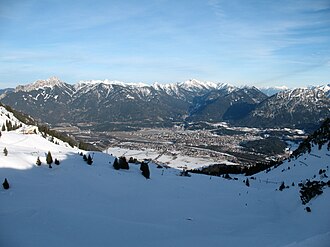Basin
As a basin , basin is one of mountains or hills around enclosed valley or geological basin called. The valley basin is typically largely surrounded on all sides by mountain slopes, round-oval-shaped, and usually only opens in a comparatively narrow passage, which distinguishes it from the elongated valley trains. In the valley floor there are largely V , trough (U-shaped) and sole valley- like (valley plains) shapes, the former are then referred to as valley funnels .
Emergence
In most of the mountains, the formation of most of the valley basins can be traced back to processes of erosion and sedimentation during the ice ages , which on the slopes can also be accompanied by the formation of river terraces or valley shoulders shaped by glaciers . Some basins were also created by narrowing the valley during the phases of mountain formation . Many basins are based on valley thrusts caused by subsidence on the mountain slopes or rockslides . Also Engtal -Abschnitte or rock steps (with waterfall often) the post-glacial erosion phases by harder rock layers form above the valley valley of (Ausräumungskessel).
Geomorphologically, valley basins can form in all sections, as a valley exit (e.g. at the terminal moraine of a large glacier), local widening of a river valley, also as a valley head or high valley . Smaller structured forms are cirques , dead ice holes , karst forms such as sinkholes , larger poljes , volcanic-geodynamic basins are calderas (collapse craters) or maars .
Designations
Names can also be found as ravines , in some volcanic regions closed depressions are also called cirques (for example on the island of Réunion). The large valley basins of the Alps are known as the inner-alpine basin , the glacier end basins that extend into the foothills as the rim-alpine basin - analogous to other mountains.
description
Valley floor
The valley floor is often occupied by a lake , a fen (or more extensive lake areas and bog complexes) or a fertile sediment basin that has fallen dry. Geomorphological classifications of the lakes (terms such as Trogtalsee , Zungenbeckensee , Karstbeckensee and others) are based on the characteristics of the valley basin in which they have developed.
climate
In terms of climate, valley basins are often favored compared to their surroundings because they are protected from cool winds and accumulated precipitation , but - especially in autumn - there can also be long-lasting cold air accumulation with heavy fog formation . In extreme cases, shielding the precipitation can lead to extremely dry locations, so that inland deserts or salt lakes develop. Inner mountain valleys can also otherwise have particularly low amounts of precipitation locally, for example the Salzburg Lungau in the middle of the Alps is considered to be particularly poor in snow. Conversely, the valley basins of some dry zones (such as the sinkholes of the Slovenian-Italian Karst) are favored by the formation of cold air lakes.
Cities, especially large cities, on the other hand, are climatically disadvantaged in basins and more susceptible to environmental pollution , such as the Stuttgart basin . Reasons are insufficient air exchange, heating of stone and asphalt with nightly heat storage and delayed cooling as well as inversion weather conditions .
Examples
Basins are therefore typically suitable as settlement areas (or at least alpine pastures at high altitudes). Many basins have long been densely populated because of their favorable location and water conditions; some striking examples are the inner cities of Stuttgart , Wuppertal , Aachen , Würzburg or Kassel as well as the cities of Berane (Montenegro), Brezno (Slovakia) or Děčín (Czech Republic). The built-up area of La Paz stretches in one of the most extensive basins in the world with an altitude difference of almost 1000 meters. Parts of the Klagenfurt basin (the largest of the inner-alpine basins), the Vienna basin (as a peripheral alpine side basin of the Pannonian lowlands) and the Elbe valley near Dresden also have the character of a spacious basin . In a broader sense, for example, the entire Bavarian-Austrian Alpine foothills is a valley basin of the Danube between the Alps, the German low mountain range threshold and the Bohemian Massif, as is the Pannonian Plain with its numerous side basins, a basin between the Alps, the Carpathians and the Dinarides.
See also
- Valley floor , valley shoulder , valley step
- Long valley , Mulde valley , sedimentary basin , denudation
Individual evidence
- ↑ see about sevengebirge.de; Climate and duration of sunshine in the Stuttgart valley basin , stadtklima-stuttgart.de
- ↑ Würzburg Basin: Why the city stays hot at night. Retrieved August 23, 2018 .

